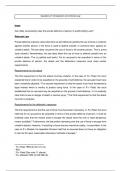Summary
Summary Professional Essay Anwer - Self Defence and Criminal Negligence
This is an example of how to answer an essay question in criminal law in south africa. It explains the principles of self-defence and criminal negligence proffessionally and in good detail.
[Show more]



